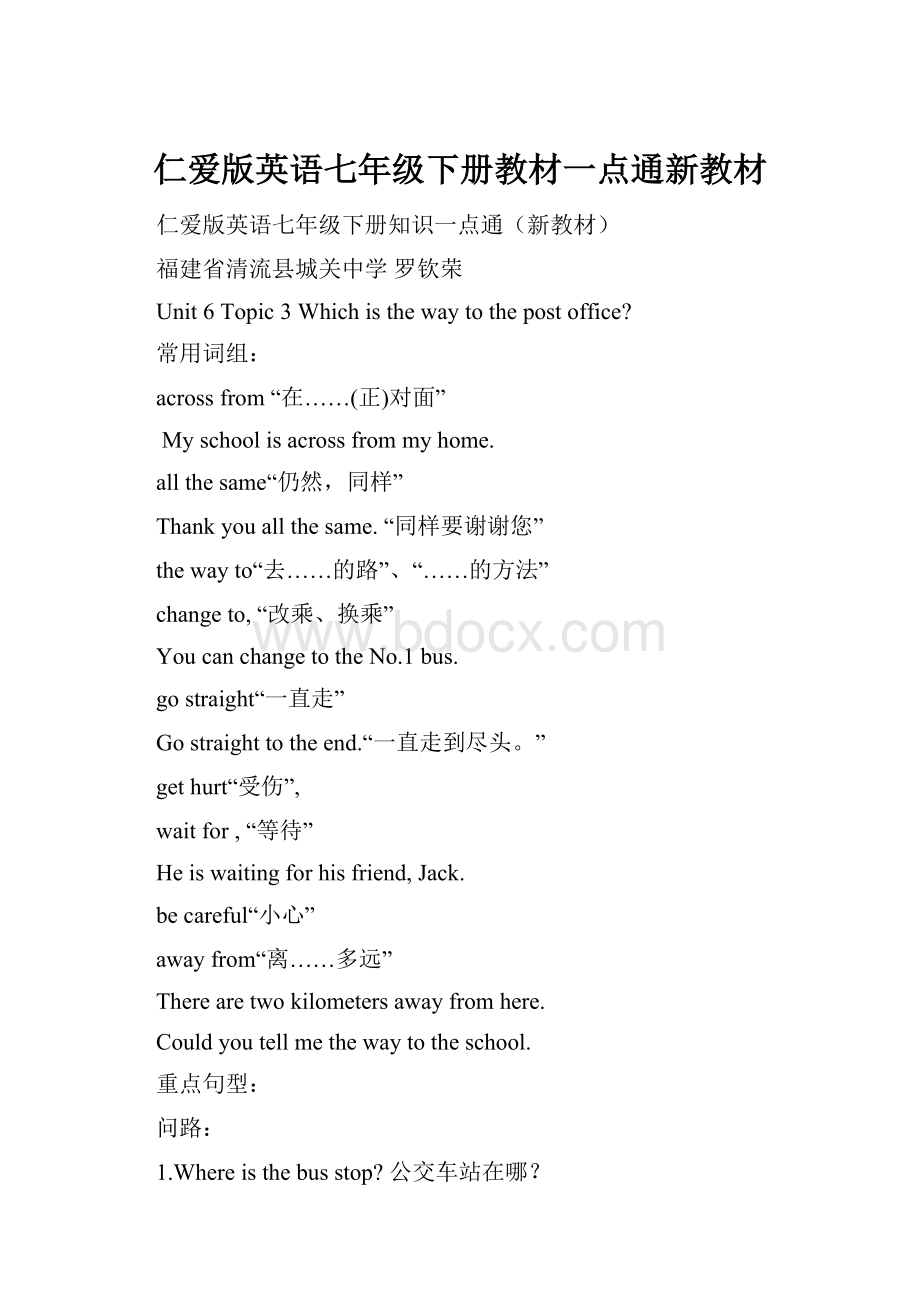 仁爱版英语七年级下册教材一点通新教材.docx
仁爱版英语七年级下册教材一点通新教材.docx
- 文档编号:17736216
- 上传时间:2023-04-24
- 格式:DOCX
- 页数:23
- 大小:35.81KB
仁爱版英语七年级下册教材一点通新教材.docx
《仁爱版英语七年级下册教材一点通新教材.docx》由会员分享,可在线阅读,更多相关《仁爱版英语七年级下册教材一点通新教材.docx(23页珍藏版)》请在冰豆网上搜索。

仁爱版英语七年级下册教材一点通新教材
仁爱版英语七年级下册知识一点通(新教材)
福建省清流县城关中学罗钦荣
Unit6Topic3Whichisthewaytothepostoffice?
常用词组:
acrossfrom“在……(正)对面”
Myschoolisacrossfrommyhome.
allthesame“仍然,同样”
Thankyouallthesame.“同样要谢谢您”
thewayto“去……的路”、“……的方法”
changeto,“改乘、换乘”
YoucanchangetotheNo.1bus.
gostraight“一直走”
Gostraighttotheend.“一直走到尽头。
”
gethurt“受伤”,
waitfor,“等待”
Heiswaitingforhisfriend,Jack.
becareful“小心”
awayfrom“离……多远”
Therearetwokilometersawayfromhere.
Couldyoutellmethewaytotheschool.
重点句型:
问路:
1.Whereisthebusstop?
公交车站在哪?
2.HowcanIgettothebusstop?
我怎样到达公交车站?
3.Whichisthewaytothebusstop?
哪条是去公交车站的路?
4.Couldyoutellmethewaytothebusstop?
你能告诉我去公交车站的路吗?
指路:
1.Goalong/Godown/GoupXinhuaStreet.沿着新华街走。
2.Turnleft/Turnrightatthefirst(second,third,fourth…)crossing.在第一个十字路口左转/右转。
3.Goacross/Crossthebridge.或Goacross/CrossXinhuaStreet.过桥。
或:
过新华街。
4.You’ll/Youcanfinditonyourleft.在你的左边你会找到它。
ontheright.在你的右边你会找到它。
交际用语:
1.HowcanIgetto“到达”…?
2.Goalong“沿着。
。
。
走”XinhuaStreetandturnleftatthefirstcrossing.
3.Couldyoutellmethewayto…?
4.Goalongthisroaduntil…(theend/thesecondcrossing).
1.-Excuseme,whichisthewaytothepostoffice?
-Sorry,Idon’tknow.I’mnew“新来的”here.
-Thankyouallthesame!
2.-Excuseme.Isthereabanknearhere?
-Yes.Goupthisstreettotheend,andyou’llfinditonyourleft.
3.Don’tplayonthestreet.
语法精粹:
祈使句。
表“请求、命令、建议”的句子。
通常是动词原形放句首。
否定句,则在前面加个Don’t。
Openthedoor,please.“请开门。
”
Don’tstandhere.“别站这。
”
Let’sgoforawalk.“去散步吧”
Unit7TheBirthdayParty
Topic1Whenisyourbirthday?
核心词汇:
January,February,March,April,May,June,July,August,September,October,November,December.
常用词组:
plantodosth.,beborn,have/takealook,usesth.for…,givesb.asurprise“给某人一个惊喜”
重点句型:
1.Howdoyouplantocelebrateit?
plantodosth.“计划做某事”
2.MichaelistalkingabouthisfavoritewriterwithKangkangafterclass.
talkabout“谈论”
talkwith/tosb.“和某人谈话”
Mymotheristalkingwithmyteacher.
3.Whenwassheborn?
Shewasbornin1996./October,1996.
ShewasbornonOctober22nd,1996.(读法:
Octoberthetwenty-second,nineteenninety-six)
Shewasbornon22ndOctober,1996.(读法:
thetwenty-secondofOctober,nineteenninety-six)
注意:
序数词前要加定冠词the.
4.Wherewereyouborn?
5.年份的英语常见读法:
1).两位数、两位数一起读:
1840:
eighteenforty.1976:
nineteenseventy-six
2).后为两个0时,则用hundred补齐:
1500:
fifteenhundred.1700:
seventeenhundred
3).2000零几年,则用:
2015:
twothousandandfifteen.2008:
twothousandandeight.
4).仅有倒数第二个数字为0时:
1908:
nineteenoeight.1303:
thirteenothree.
Whatshapewasitamomentago“一会儿前”?
amomentago
Waitamoment.“请稍等”
6.Howlong/wide/highisit?
“它有多长/多宽/多高?
”
It’sfivemeterslong.
It’stwopointfivekilometerswide.注意:
小数点的读法。
2.5:
twopointfive
It’stwenty-sixcentimetershigh.
7.What’stheshapeof…“……的形状如何?
”
What’stheshapeofyoureraser?
=Whatshapeisyoureraser?
It’sacircle/arectangle/atriangle/asquare/anoval.注意这几个词是名词,前面要加a或an。
8.havealook=takealook“看一看”,后面如果要接宾语,则要加个at。
MayIhavealook?
=MayItakealook?
MayIhavealookatyourphoto?
=MayItakealookatyourphoto?
9.Whatdoweuseitfor?
Iusetheknifeforcuttingthewatermelon.
Iusetheknifetocutthewatermelon.
10.Whatdoeshelooklike?
“他长什么样子?
”
Helookslikehisfather.“他看起来像他的父亲。
”注意:
looklike“看起来像……”
Whatishelike?
“他长什么样子?
”
Heislikehisfather.“他像他的父亲。
”注意:
belike“像……”
Thetwinsareliketheirmother.“这对双胞胎像她们的母亲。
”
交际用语:
1.-Wouldyouliketocome?
-Yes.I’dloveto./I’dliketo.
2.-Whatdayisittoday?
-It’sSaturday.
3.-What’sthedatetoday?
-It’sMay5th,2007.
4.-CanIhavealook?
-Sorry,I’mafraidyoucan’t.
语法精粹
1.序数词的记忆口诀:
1,2,3特殊记:
first,second,third
th从4往上记:
fourth,sixth,seventh,…(4以上的序数词均要加th)
f来把ve替:
five→fifth,twelve→twelfth
8减t,9减e:
eighth,ninth
y要变ie:
twenty→twentieth,thirty→thirtieth,forty→fortieth,fifty→fiftieth,…
若是碰到几十几,变化个位就可以:
twenty-one→twenty-first,thirty-two→thirty-second,forty-three→forty-third.
注意:
序数词前要加定冠词the。
读的时候要在前面加个the。
如果序数词前有形容词性物主代词,则不用加the。
Shewroteherfirstnovelattheageoftwenty.
Topic2CanyousinganEnglishsong?
常用词组:
haveagoodtime/enjoyoneself“玩得高兴,过得愉快”;take…to“把……带到……”;
takephotos/takepictures,“拍照片”;
begoodat/dowellin“擅长做……”
Ienjoyedmyselfyesterday.
Ihadagoodtimeyesterday.
haveagoodtime中的good可以用nice,great,wonderful来替换。
Sheoftentakesherchildtoheroffice.
Heisgoodat/doeswellindrawing.
重点句型:
1.Oh,doyouwanttosingChinesesongsorEnglishsongs?
“你是唱中文歌还是英文歌?
”
or“和、又”,用于否定句。
Don’trunorplayinthestreet.“别在路上跑和玩。
”
and“和、又”用于肯定句中。
Shecansingsongsanddance.“她会唱歌和跳舞。
”
Shecan’tsingsongsordance.
注意:
or还有“或者”的意思。
表选择。
2.Whatelsecanyoudo?
else放在what、who和不定代词something或anything后。
“其他的,别的”
Anythingelse?
还有其他的吗?
Ihavesomethingelsetodo.我有其他的事要做。
3.Therewassomethingwrongwithhereyes.
形容词作定语,放在不定代词后。
anythingnew“崭新的一切”;somethingimportant“重要的事”。
4.I’dliketodancetodisco.我想跳迪斯科。
5.I’dliketotaketheseflowerstotheparty.“我想带这些花去派对。
”
take……to……“带……去……。
”
Jane’smotheroftentakeshertothepark.
Takeyournotebooktoschooltomorrow,please.“明天请带你们的笔记本到学校。
”
6.IlikeEnglishalittle.“我有点喜欢英语。
”
IlikeEnglishverymuch/alot.“我非常喜欢英语。
”
IlikeEnglishbest.“我最喜欢英语。
”
Idon’tlikeEnglishatall.“我一点也不喜欢英语。
”
7.注意:
thousand“千”,hundred“百”的用法。
前面有具体数字,遵从“有头无尾”原则。
twothousandstudents.“两千个学生。
”
threehundredstudents.
前面没有具体数字,遵从“拖泥带水”原则。
注意:
这里把单词后的s及of理解成“泥和水”。
thousandsofstudents.“成千上万个学生。
”
hundredsofstudents.“上千个学生。
”
8.It’stimefor+名词/代词。
It’stimeto+动词原形。
It’stimeforoutdooractivities.该是户外活动的时间了。
It’stimetodooutdooractivities.该是做户外活动的时间了。
9.Butoneyearago,shecouldn’tflyakiteatall.
一段时间+ago“……(多长时间)前”,是一般过去时的时间状语(也叫信号词)。
oneweekago“一周前”;twomonthsago“两个月前”;threeyearsago“三年前”
HelivedinBeijingfiveyearsago.“五年前他住在北京。
”
JanecametoChinasixmonthsago.“简六个月前来到中国。
”
10.Theybothlikeplayingballgame.“他们俩个都喜欢打球。
”
Thechildrenareallhavingagoodtime.“孩子们都玩得很高兴。
”
放在be动词之后,行为动词前。
both“(两者)都”
all“(三者或三者以上)都”
11.Shecouldn’tflyakiteatallinthepast.
inthepast“在过去。
”是一般过去时的时间状语(也叫信号词)。
Theywereverypoorinthepast.“过去他们非常穷。
”
12.Attheageoffive,shecouldplaythepianoverywell.
attheageof……。
“在……岁时”
13.Janecouldnotseeanythinganymore.“简再也看不到东西了。
”
not……anymore“不再”
Iamnotastudentanymore.“我不再是个学生了。
”
14.Withhermother’shelp,Jennycanwritewellnow.“在她母亲的帮助下,简现在能够写得很好了。
”
withone’shelp=withthehelpof……“在某人的帮助下”
Withthehelpofhermother,Jennycanwritewellnow.
交际用语:
1.-Canyoudance?
-Yes,Ican./Yes,alittle./Yes,verywell./Yes,butnotverywell.“但不是很好。
”
-Canyoudraw?
-No,Ican’t./No,notatall.
2.Happybirthdaytoyou!
3.Youaresosmart!
Unit7Topic3知识点重难点解析:
1.重要的短语:
performmagictricks“表演魔术”/performballet“跳芭蕾”/performkungfu“表演功夫”;falldown“摔倒、跌倒”;atonce“立刻、马上”;nexttime“下次”;byhand“手工”;makeawish“许个愿望”;sitaround“围着……坐。
”
2.enjoyoneself“玩得高兴,过得愉快”=haveagoodtime.
IenjoyedmyselfatKangkang’sbirthdaypartyyesterday.
=IhadagoodtimeatKangkang’sbirthdaypartyyesterday.
注意:
1)反身代词oneself变化如下:
第一二人称用形容词性物主代词+self(selves)
I→myself;we→ourselves;you→yourself(yourselves)
第三人称用人称代词宾格+self(selves)
he→himself;her→herself;it→itself;they→themselves
2)enjoy的另一个重要用法:
enjoy+V.ing形式。
“喜欢做某事”
Sheenjoysplayingthepianoinherfreetime.“业余时间她喜欢弹钢琴。
”
3.What’sthematter?
“……怎么了?
/……有什么毛病?
/……不舒服?
”
后面要加宾语的时候,一定要和with连用。
What’sthematterwithyourcomputer?
“你的电脑怎么了?
”
What’sthematterwithyou,Jack?
“杰克,你哪不舒服?
”
注意:
What’sthetroublewithyourcomputer?
What’swrongwithyourcomputer?
4.tellsb.todosth.“告诉某人做某事”
Herfathertoldhertocomebackearlynexttime.
asksb.todosth.“请求某人做某事”
JaneaskedmetohelpherwithherEnglishyesterday.
5.Weboughtmanypresentsforhim.=Weboughthimmanypresents.
sth.sb.sb.sth.
注意:
buysth.forsb.=buysb.sth.“给某人买某物。
”
6.bringsth.from+“地点”:
HebroughtanEnglishbookfromhishome.“从……带来。
”
takesth.to+“地点”:
HetookanEnglishbooktoJane’shome.“带……去。
”
7.Heblewoutthecandlesonthebirthdaycake.“他吹灭了生日蛋糕上的蜡烛。
”
注意:
blowout“吹灭”,是动词+副词构成的短语,代词必须放中间。
名词可以放中间也可以放后面。
Heblewthemout.“他把它们吹灭了。
”
已学过的相似的动词短语有:
putaway“把……放好,收好”;tryon“试穿”;workout“算出,解决”;puton“穿上,戴上”等等。
定冠词the的用法:
1.乐器前要带the:
playtheguitar/piano;
球类前不带the:
playsoccer/basketball;
2.序
数词前要用the:
onthesecondfloor;
3.三
餐前不用the:
havebreakfast/havelunch/havesupper
常见介词(in,on,at)的用法:
1.在几点常用介词at:
at8:
10;at12:
00;atnight(特例)
2.在早上、下午、晚上常用in:
inthemorning/intheafternoon/intheevening.
3.在月份或年份前用介词in:
in2005;inMay,2015
4.在在星期几常用on:
onSunday;
具体到某一天的早上/下午/晚上,用on:
onSundayafternoon;onthecoldmorning;
2.在哪一层楼用介词on.
一般过去式
一、一般过去式表示:
表达:
说话之前发生的动作或存在的状态。
Myfatherwasatworkyesterdayafternoon.
Igotupat6:
30yesterday.
Healwayswenttoworkbybuslastyear.
二、动词过去式的构成:
1.规则动词
在动词后面直接加“ed”:
play-played
动词以“e”结尾加d:
move-moved
动词以辅音字母加y结尾改y为i加ed:
study-studied
动词为重读闭音节,双写词尾的辅音字母加ed:
plan-planned;stop-stopped
2.不规则动词(详情见书后P148的不规则动词表)
am/is-was;are-were;do-did
三、常用的时间状语(信号词):
一段时间+ago:
twodaysago/threemonthsago/fouryearsago;
in+过去的时间:
in2002,inMay,1999;
on+过去的具体时间:
onSeptember10th,2014;
lastyear/lastweek/lastmonth;inthepast;justnow;yesterday等。
四、1).行为动词一般过去时态陈述句变否定句和一般疑问句:
肯定句:
Iboughtsomebooksyesterday.
否定句:
Ididn’tbuyanybooksyesterday.
一般疑问句及简略回答:
—Didyoubuyanybooksyesterday?
—Yes,Idid./No,Ididn’t.
2).be动词的过去式
am/is→w
- 配套讲稿:
如PPT文件的首页显示word图标,表示该PPT已包含配套word讲稿。双击word图标可打开word文档。
- 特殊限制:
部分文档作品中含有的国旗、国徽等图片,仅作为作品整体效果示例展示,禁止商用。设计者仅对作品中独创性部分享有著作权。
- 关 键 词:
- 仁爱 英语 年级 下册 教材 一点 新教材
 冰豆网所有资源均是用户自行上传分享,仅供网友学习交流,未经上传用户书面授权,请勿作他用。
冰豆网所有资源均是用户自行上传分享,仅供网友学习交流,未经上传用户书面授权,请勿作他用。


 #全自动电容电感测试仪.docx
#全自动电容电感测试仪.docx
